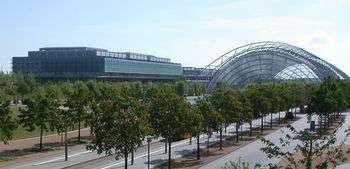
Leipzig Book Fair
The Leipzig Book Fair (German: Leipziger Buchmesse) is the second largest book fair in Germany after the Frankfurt Book Fair. The fair takes place annually over four days at the Leipzig Trade Fairground in the northern part of Leipzig, Saxony. It is the first large trade meeting of the year and as such it plays an important role in the market and is often where new publications are first presented.
History
The Leipzig Book Fair became the largest book fair in Germany in 1632 when it topped the fair in Frankfurt am Main in the number of books presented. It remained on top until 1945 when Frankfurt surpassed it to regain the number one spot. During the GDR era the fair remained an important meeting place for book lovers and sellers from both East and West Germany. After unification, the fair moved from the Trade Fair House on the main market square to a new location removed from the city center. After the move, the fair experienced a renaissance and continues to grow today.
Leipzig Book Fair Prize
The Leipzig Book Fair Prize (German: Preis der Leipziger Buchmesse) is a literary award assigned annually during the Leipzig Book Fair to outstanding newly released literary works in the categories "Fiction", "Non-fiction" and "Translation". It has been called "the second most important German book-prize, after the German Book Prize". The winner in each category is awarded € 15,000.
Award winners
2005
2006
2007

Trade fair
A trade fair (trade show, trade exhibition, or expo) is an exhibition organized so that companies in a specific industry can showcase and demonstrate their latest products, service, study activities of rivals and examine recent market trends and opportunities. In contrast to consumer fairs, only some trade fairs are open to the public, while others can only be attended by company representatives (members of the trade, e.g. professionals) and members of the press, therefore trade shows are classified as either "public" or "trade only". A few fairs are hybrids of the two; one example is the Frankfurt Book Fair, which is trade only for its first three days and open to the general public on its final two days. They are held on a continuing basis in virtually all markets and normally attract companies from around the globe. For example, in the U.S. there are currently over 10,000 trade shows held every year, and several online directories have been established to help organizers, attendees, and marketers identify appropriate events.
Podcasts:

